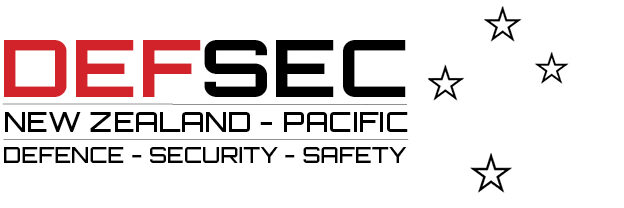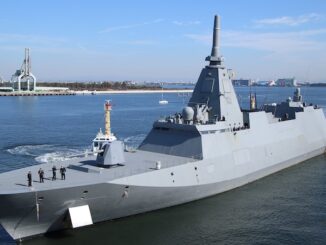
Is it time for New Zealand to add a Naval Strike munition to its inventory?, writes former RNZN Chief Petty Officer (Combat System Specialist – Above Water Warfare) Jonathan Brooke.
On arriving at the Devonport Naval Base by road, the first thing you will notice is a large naval turret. The 6-inch BL MKXXII naval gun is ‘Y’ turret — one of the main turrets on HMNZS Achillies, a ship famously involved in the Battle of the River Plate against the ‘pocket battleship’ Admiral Graf Spee in the South Atlantic on 13 December 1939.
The reason I mention it is that this gun alone didn’t win the battle. The collective weight of fire from multiple ships overwhelmed the German commander’s initiative, leading him to scuttle the Graf Spee to avoid futile engagement and probable loss of his crew.
For decades post-WWII, New Zealand has maintained a defence posture centred on a primarily defensive capability. However, as global threats evolve and strategic competition in the Pacific intensifies, the recently released 2025 Defence Capability Plan (DCP) signals a long-overdue but critical shift: New Zealand will now pursue a strike capability.
This opens the door to an essential question: what is the right tool for a modern surface engagement? If the 6-inch gun was the right tool in 1939, what meets our needs in a multi-domain, dispersed, high-threat maritime environment today?
Strategic Context: Evolving threats in our region
The Pacific, once considered a relatively benign environment, is now marked by increasing geopolitical competition as widely reported. With growing tensions and challenges to regional stability, it is entirely appropriate that New Zealand is moving to acquire the means to conduct over-the-horizon strikes against hostile — though not exclusively maritime — targets.
A naval strike munition for Anti-Surface Warfare (ASuW) — capable of being directed by space assets, RNZAF P-8A Poseidons, Army or allied Joint Terminal Attack Controllers (JTACs), or deployed on future surface combatants, crewed or uncrewed — will provide a key enhancement to New Zealand’s maritime defence strategy.
Why the Kongsberg Naval Strike Missile (NSM) makes strategic sense
The Kongsberg NSM, already fielded by key allies and will be manufactured in Newcastle, Australia in a brand new factory, emerges as a logical and timely choice. This local production drastically improves logistical support, sovereignty of supply, and sustainment. It is:
- Field-proven with warships operated by the U.S., Norway, Australia, and others.
- Stealthy, sea-skimming, and network-enabled, with a proven ability to evade modern air defences.
- Easily integrated into existing NZDF command systems and adaptable for deployment across air, land, and sea platforms.
New Zealand’s proximity to the Newcastle manufacturing facility means shorter supply chains, enhanced resilience in wartime conditions, and ease of replenishment — all while supporting regional defence industry.
How this enhances deterrence
The addition of a naval strike munition increases our effective engagement range and adds complexity for any adversary planning to neutralise NZDF combat power. Instead of being restricted to reactive coastal defence, we gain the ability to strike at distance — taking the fight beyond the horizon and deterring threats before they reach our shores.
In military exercises over many years, the NZDF has trained for these scenarios — over-the-horizon targeting (OTHT), joint fires coordination, and simulated maritime strike — all without ever possessing the munition to execute them in reality. Transitioning from simulated “paper missiles” to a true strike capability is not a radical change, but rather the final step in operationalising decades of professional training.
The user requirements for a modern naval strike capability should be:
- Interoperable – Easily integrated into coalition task groups and exercises.
- Modular and adaptable – Suitable for both current and future combatants.
- Flexible – Employable via multiple platforms across the joint force.
Allied navies are already advancing concepts for at-sea reloading via heavy jackstay, potentially enabling forward replenishment and longer deployments.
Strategic and policy alignment
Integrating a naval strike capability reinforces New Zealand’s commitment to the international rules-based order and the collective security of the Indo-Pacific. It moves us from being a passive participant to an active contributor with a credible deterrent. The benefits are manifold:
- More resilient task group operations.
- Greater leverage in alliance-based deterrence.
- Reduced reliance on others for precision strike during crises.
Conclusion: A logical next step in defence evolution
With the Defence Capability Plan’s shift toward acquiring strike capability, New Zealand stands at a decision point. The Naval Strike Missile, backed by trusted partners and soon produced just across the Tasman, is the right tool for the job.
It is a weapon that enables defence-in-depth, expands operational flexibility, and places New Zealand firmly within a future-focused coalition deterrence architecture. This is not about being aggressive — it is about ensuring credible deterrence, this was demonstrated by ‘Y’ turret and the naval lesson is still applicable.
Now, more than ever, it is time to move forward, a shield can only protect if it is backed by reach.






Be the first to comment